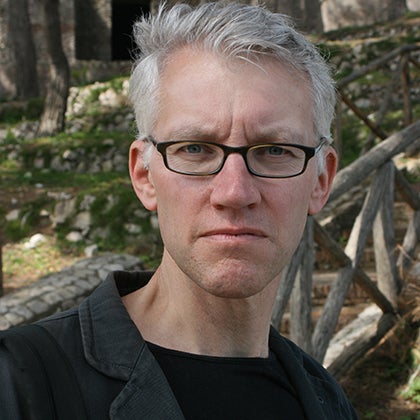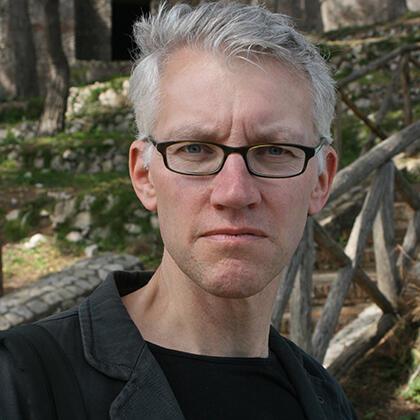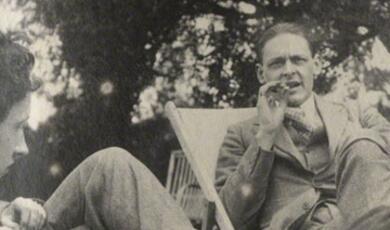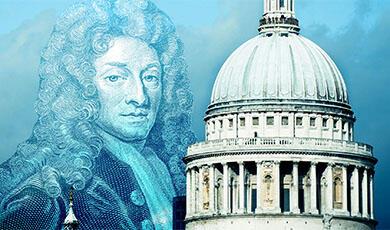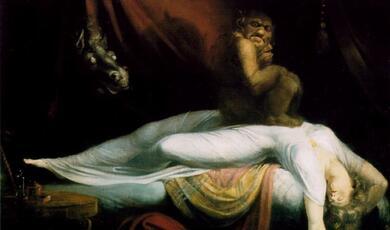Pilgrimages, Pandemics and the Past
Share
- Details
- Transcript
- Audio
- Downloads
- Extra Reading
Between us and the medieval men and women who went on pilgrimage there stand many impediments to understanding: the Reformation, the Enlightenment, secularisation.
This lecture will explore how tracing ancient routes on foot, and experiencing travel as people did in an age before trains and cars, can offer insights into the past. But is the sense of being accompanied by ghosts a delusion?
Tom Holland will draw on experiences of reading Chaucer and undertaking pilgrimages during and after the pandemic.
Download Transcript
Pilgrimages, Pandemics and the Past
Tom Holland
7 November 2023
Pilgrimage to Stonehenge: Roads not taken
- Early in 2020, my brother and I planned a pilgrimage to Stonehenge to protest the UK Government’s plans for a road tunnel through the sacred landscape that surrounds Britain’s most celebrated historic monument. However, we soon encountered a problem: Where to start?
- Undoubtedly, Stonehenge was a place of pilgrimage in the Neolithic, but we have no way of knowing if there were particular locations in Britain from which pilgrims were inspired to travel. Therefore, we drew on archaeology instead.
- On assumption that ‘The Amesbury Archer’ had crossed the English Channel at its narrowest point, we decided to start from Dover.
- Lockdown interrupted our plans but heightened our enthusiasm and curiosity about the practice of pilgrimage in times of crisis and ill health.
- When April turned out to be glorious, it focused my attention on the most celebrated pilgrim in our history and decided to follow on his footsteps.
What that April, with his shoures soote…
- April 2020 was one of the cruellest months for everyone, darkened even more by lockdown. During these troubling times, I returned to the Canterbury Tales.
- I was able to note similarities between the Present and Past Pandemic, as Chaucer lived in the shadow of the Black Death (Summer of 1348).
- Chaucer was only a young child when, in June 1348, the first case of the plague was reported, and by April 1349, the plague had laid waste on Chaucer’s relations in London. This was, perhaps, the making of the young Chaucer, since both his father and mother left substantial properties.
- By the time Chaucer comes to write the Canterbury Tales, London has recovered: The city was buzzing with teeming docks, the superimposition of cranes and the expansion of houses upwards, welcoming loft conversions.
- However, the plague loomed, and the pandemic soon became endemic, a constant background presence that threatened everyone, all the time.
Canterbury Tales
- The presence and dangers of the plague was present throughout the Canterbury Tales. We have that In the Knight’s Tale, Saturn boasts to his daughter, Venus, ‘My looking is the fader of pestilence.’ Then, in the Pardoner’s Tale, there is an even more explicit reference when three rioters are told news of a friend:
“Ther cam a privee theef men clepeth Deeth,
That in this contree al the peple sleeth
And with his spere he smote his herte atwo,
And wente his way without wordes mo,
He hath a thousand slayn, this pestilence.”
- The rioters proceed to go in search of Death, claiming ‘Deeth shal be deed.’ They are told that Death is to be found under a tree, but when they get there, they can only see a hoard of golden florins for which they end up fighting and killing each other. It is a haunting and fabulous tale, but it is also rooted in experience.
- Italian writer Giovanni Boccaccio reflected that people responded in different ways to the Black Death, one of them was ‘wild living’. For English moralists, this kind of immorality during plague times was a constant theme, with Thomas Walsingham, a monk at St Albans, declaring that people of London ‘Of all people, they were the proudest, the most arrogant, the most greedy’.
Pilgrimage
- That April, during the first weeks of the lockdown, I was alert to the goal of Chaucer’s pilgrims as I had never been before.
“…to Caunterbury they wende,
The hooly blisful martir for to seke,
That hem hath holpen whan that they were seeke.”
- In a pandemic-ravaged world still in the early days of waiting for a vaccine, the yearning for the benediction that might be received at St Thomas’ shrine seemed vivid to me as it had never been. For Chaucer, there were particular reasons to hold St Thomas in veneration. His parish church as a boy, St Martin Vintry, had an altar to St Thomas, and as an adult, Chaucer would repeatedly have taken the pilgrim route while he was on missions to Calais and beyond.
Chaucer’s pilgrims never arrive in Canterbury.
- By the time they reach the limits of the city, it is as though they are like aircraft, kept in a holding pattern.
- But what I had not fully contemplated, before that spring of 2020, was how they had failed to start their pilgrimage properly as well, since they did not leave for Canterbury from the shrine to St Thomas on London Bridge – they begin it in an inn.
“Bifil that in that seson on a day,
In Southwerk at the Tabard as I lay,
Redy to wenden on my pilgrymage
To Caunterbury with ful devout corage,
At nyght were come into that hostelrye
Wel nyne and twenty in a compaignye
Of sondry folk, by áventure y-falle
In felaweshipe, and pilgrimes were they alle,
That toward Caunterbury wolden ryde.
The chambres and the stables weren wyde,
And wel we weren esed atte beste.
And shortly, whan the sonne was to reste,
So hadde I spoken with hem everychon,
That I was of hir felaweshipe anon…”
- Walking the pilgrimage route through Southwark in April 2020, it was shut: There were no crowded bars, no meeting up with strangers and no socialising. This struck me anew: The Canterbury Tales is a celebration of everything that comes from not having to socially distance.
- I wondered anew at the first line of the poem: The insistence on April. I wondered if was there something more than the lengthening of the days that made people long “to goon on pilgrimage”?
- April seemed to be a significant month. Chaucer specifies that it always rains in April, but what he did not specify was that April was also the month, traditionally, when the plague began to abate in London, even if this was not true for other countries (strangely, in Italy, fatalities worsened drastically in May). No germ theory – but people in the 14th century understood the concept of social distancing.
- Is this, then, why Chaucer specifies the time of year when his pilgrims meet at the Tabard, and embark on their journey to Canterbury? Is the whole great cycle of the Canterbury Tales a eulogy to the joys, in a time of an endemic plague, of social mixing?
I don’t know –but I wanted, desperately, as I was reading the Canterbury Tales during lockdown, to believe it
Closer to Chaucer:
- I took inspiration from Marion Turner: Chaucer: A European Life
- “To try to understand the imagination of the poet, throughout this book I explore the things that surrounded him, the streets he walked, the communities in which participated, and the structures that he inhabited.”
- At the same time, I felt with a renewed ache a sense of the distance that separated me from the 14th century. For instance, if I felt in my longing for the vaccine an echo of the yearning that the pilgrims might have had to reach the shrine of St Thomas – “that hem hath holpen whan that they were seeke” – then that only brought home to me how utterly dissolved, upon the Reformation and all that had followed it, that age of pilgrimage was.
- My materialism, I realised, had prevented me from taking Chaucer’s pilgrims – and Chaucer himself – seriously. I had been too seduced, perhaps, by the comedy, the romance, the sublimely deft sketches of character, to recognise the ache of need, the yearning.
- In the concluding sentence of the Canterbury Tales, Chaucer prays to Christ, the Virgin and to all the saints of heaven for salvation, “thurgh the benigne grace of hym that is kyng of kynges and preest over alle preestes, that boghte us with the precious blood of his herte, so that it I may been oon of hem at the day of doom that shulle be saved.”
Now, here’s the question – was I right?
- History is not a science – we are all of us shaped by our experiences of the present in the judgements we bring to the past.
- “The captain of the Hampshire grenadiers (the reader may smile) has not been useless to the historian of the Roman empire” - Gibbon
- Yet equally, it is incumbent on us to respect the strangeness of the past – its otherness, if you like
- The status of the Canterbury Tales in the canon is due, not to its distance from us, but to its apparent closeness.
- The pilgrims offer us a cross-section of middle England.
- The multiplicity of perspectives, the range of voices, are appealing to our literary sensibilities in a way that, say, the allegory of Piers Plowman is not.
- There is a reason why novelists or script writers find it so adaptable.
- And yet, at the same time, these similarities can be deceptive.
- There are two very obvious reasons why, in the 21st century, many of us may be ill qualified to comprehend the significance, the resonance, the timbre of pilgrimage:
- We live in a culture that for half a millennium has been Protestant.
- The cult of St Thomas is gone from Canterbury Cathedral
- Henry VIII’s agents, in 1538, destroyed what Erasmus had hailed as “a shrine of gold.”
- Nothing remains of the holy blissful martyr sought by Chaucer’s pilgrims.
- We live in a culture that for half a millennium has been Protestant.
- But more saliently than that, we live in a culture – and perhaps especially an academic culture – that is determinedly materialist.
- I have read many books on the Canterbury Tales, & in none of them, I think, have I ever come across a suggestion that miracles might actually have been performed at St Thomas’ shrine.
- Yet Chaucer – a man who throughout his life enjoyed intimate ties to religious institutions, & was buried in Westminster Abbey, not as a poet, but as a man bound by close ties to the monks – undoubtedly believed that they were.
- The venemous brilliance of his portrayal of the Pardoner – a swindler who makes his living by exploiting the faith of the devout – derives from precisely that.
- Pilgrimage in the Canterbury Tales is not merely a plot device.
- To assume otherwise is to be guilty of grievous anachronism.
Making Sense of Pilgrimage: Why the upsurge in pilgrimages in 11th century
- These, in the opinion of a monk in the great Burgundian abbey of Cluny, “portended nothing other than the advent of the accursed Antichrist, who, according to divine testimony, is expected to appear at the end of the world.”
- The monk recognised in it a yearning for Christ, a yearning for earth to be joined to heaven, that paralleled that of Cluny itself. The ambition of the Cluniacs was nothing less than to emulate the angelic choirs of paradise; they did this by singing. Singing psalms, hymns, praises, all day, to an unprecedented degree. The truest mark of their angelic status was that they could boast a purity deriving from their independence of earthly lords.
- Exceptionally, and unlike other monasteries, Cluny owed no obedience to a prince, to a king, to an emperor, but St Peter. Only St Peter, and his far-off deputy, the Pope in Rome.
- In 1033, a great mass of pilgrims from Latin Christendom arrived in Jerusalem. There was no joining of heaven to earth – not second coming of Christ… But Cluny remained. This was proof to its admirers that heaven could indeed be established on earth, and that a new Jerusalem might be built.
- Just as Cluny had cleansed itself of the grubby fingerprints of earthly lords, so were there many reformers who dreamed of cleansing the entire Church in a similar manner. However, such an ambitious project would, of course, need leadership. As a consequence, over the course of the 11th century, the papacy emerged from what it had previously been – the plaything of vicious Roman nobleman, the tool of domineering emperors – to become something very different. There was now a focus for an attempt to change the whole world.
- The result was what has been described variously as the papal or the Gregorian revolution (after Gregory VII, the most celebrated of the 11th century popes, the man who brought an emperor to kneel before him in snow at Canossa).
- The great project of cleansing the Church of earthly control was a momentous one, with seismic consequences.
- The Church was cast as belonging to the dimension of religio, what in Latin meant the bond between humanity and the heavens, while earthly rulers were cast as creatures of the saeculum, the dimension of all those borne upon the currents of time.
- Gregory and his fellow reformers did not invent the distinction between religio and the saeculum, between the sacred and the profane; but they did render it something fundamental to the future of the West, “for the first time,” in the words of R. I. Moore, “and permanently.”
The Heirs of Revolution
- This, perhaps –ironically enough– may help to explain why there has been a certain squeamishness among scholars when it comes to acknowledging just what the significance of the pilgrimages that marked the early years of the 11th century might have been – and especially the great pilgrimage to Jerusalem of 1033.
- For 1033 was, of course, the millennial anniversary of the death and resurrection of Christ.
- The notion that the date might have had any significance to Christians has long been seen by historians as a febrile & flamboyant concoction of the Romantic Era.
- In academic circles, the profound changes which affected western Europe during the 10th and 11th Centuries have conventionally been explained almost entirely in terms of economics.
- Yet, recently, the consensus on this has begun to shift. Just as the experience of Covid has provided a correlative for the vastly greater catastrophe that was the Black Death, so have two recent developments helped to buck what was for so long an impregnable orthodoxy.
- 1. The experience of a millennium: hardly a coincidence that opinion on the significance of the first millennial anniversary should have picked up such pace over the years that immediately preceded and followed the year 2000.
- 2. Anxieties about climate change
- “Our future,” James Lovelock wrote in 2006, “is like that of the passengers on a small pleasure boat sailing quietly above the Niagara Falls, not knowing that the engines are about to fail.”
- More than a thousand years ago, an abbot of Cluny drew upon a very similar metaphor.
- The vessel that bore sinful humanity, St Odo warned, was beset all around by a gathering storm surge: “Perilous times are menacing us, and the world is threatened with its end.”
- “Our future,” James Lovelock wrote in 2006, “is like that of the passengers on a small pleasure boat sailing quietly above the Niagara Falls, not knowing that the engines are about to fail.”
The parallels are hardly exact, of course – and yet they are suggestive enough, I think, to help historians in 2023 overcome their instinctive materialism, and take seriously the spiritual anxieties and yearnings that in the 11th century served to power a revolution
They offer reflections, perhaps, that do indeed flicker and twist in a distant mirror
But what if we go even further back in time? Back to a time before materialism, before Protestantism, before Christianity itself?
A Final Journey
• A journey undertaken by young girls in the heyday of classical Athens.
• Every 4 years, girls under the age of 10 would process from Athens itself to a temple on the Attic coast named Brauron. The shrine of Brauron was sacred to Artemis, the virgin huntress, the Mistress of Beasts.
• Artemis was a fearsome goddess, capable of inflicting untold disaster on a city if not shown due respect – and sure enough, it was to appease the anger of Artemis that the girls of Athens would head to Brauron.
• Once, it was said, a group of Athenians had killed a bear sacred to Artemis – and so the goddess had sent a plague to devastate the city.
“The Athenians consulted Delphi,” we are told, “and were informed that the plague would only be brought to an end if their young daughters, as blood price for the death of the beast, were obliged to become bears. So it was that a law of the Athenians forbade any girl being given in marriage unless she had first turned into a bear and served Artemis.”
- Lots of theories about what might be going on here:
- Puberty rite
- Initiation rite
- An expiation rite
- But what no scholar today would dream of suggesting is what the sources tell us: That the girls did actually turn into bears.
- This is hardly surprising: if scholars today tend not to assume that miraculous healing took place at the shrine of St Thomas in Canterbury, then how much more impossible is it for them to accept that the goddess who had her cult at Brauron was actually real. Yet, by refusing to countenance that possibility, we immediately place ourselves irredeemably outside the lived experience of the ancient Athenians.
- We lay claim to a knowledge of the classical past superior to those who actually experienced it. Yet, how valid is our knowledge? How accurately can we hope to understand the Athenians if we refuse to take seriously beliefs that animated their entire way of life?
“What would their celebrated politeia look like if we no longer viewed it through the lens of conventional historicism, using our standard modern analytical template? How different does their demokratia appear when we try to see it more on their terms, in the world of their experience?”
- Greg Anderson in The Realness of Things Past
- In his attempt to answer this question, he touches on the Brauronia.
- He points out “a general perception that gods felt a special affinity with human females,” as they are closer to the divine than men.
- There are two salient features of the Brauronia:
- The girls become bears.
- They spend time with Artemis in a way that no boy does.
- Every Athenian man who marries an Athenian woman knows this. Therefore, a nervous respect emerges.
- There are also implications for our understanding of the Athenian democracy.
- Men vote for the same reason they fight: It is their duty to maintain the viability of their city in the earthly dimension.
- Women perform rituals that enable them to ensure divine protection for Athens.
- This is not less important than voting or fighting – in many ways, it is more important.
“A primordial cosmic ecology of gods, land and people.”
© Tom Holland 2023
References and Further Reading
The Canterbury Tales by Geoffrey Chaucer:
Chaucer: A European Life by Marion Turner:
Millennium by Tom Holland
The Apocalyptic Year 1000: Religious Expectation and Social Change, 950-1050, ed. Richard Landes, Andrew Gow and David C. Van Meter
The Realness of Things Past: Ancient Greece and Ontological History by Greg Anderson
The Wolf-Girl, the Greeks and the Gods by Tom Holland
© Tom Holland 2023
The Canterbury Tales by Geoffrey Chaucer:
Chaucer: A European Life by Marion Turner:
Millennium by Tom Holland
The Apocalyptic Year 1000: Religious Expectation and Social Change, 950-1050, ed. Richard Landes, Andrew Gow and David C. Van Meter
The Realness of Things Past: Ancient Greece and Ontological History by Greg Anderson
The Wolf-Girl, the Greeks and the Gods by Tom Holland
This event was on Tue, 07 Nov 2023
Support Gresham
Gresham College has offered an outstanding education to the public free of charge for over 400 years. Today, Gresham plays an important role in fostering a love of learning and a greater understanding of ourselves and the world around us. Your donation will help to widen our reach and to broaden our audience, allowing more people to benefit from a high-quality education from some of the brightest minds.


 Login
Login
